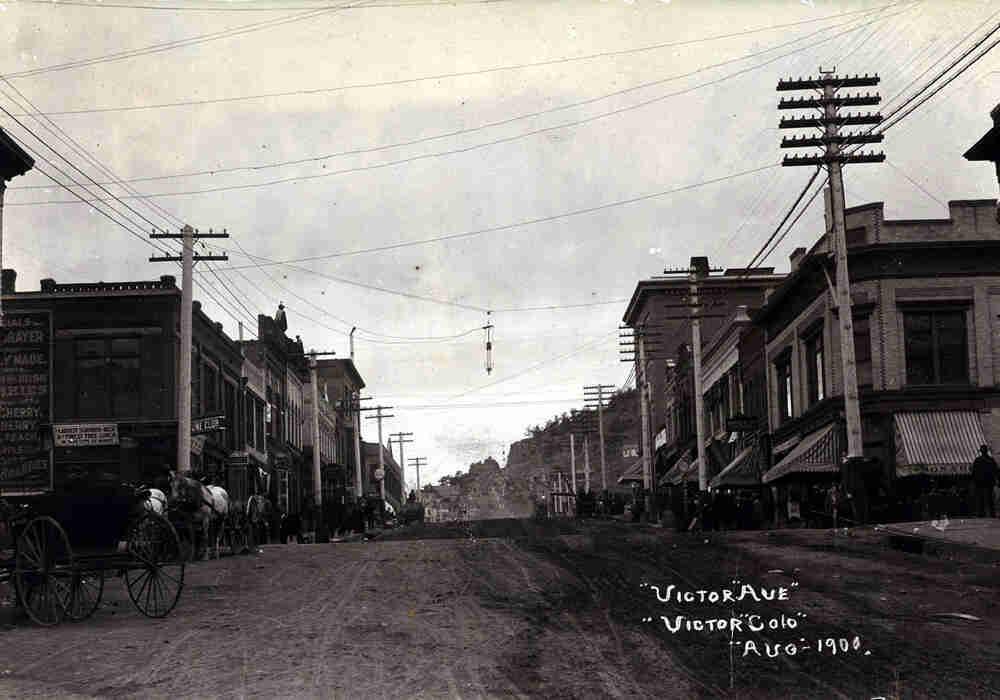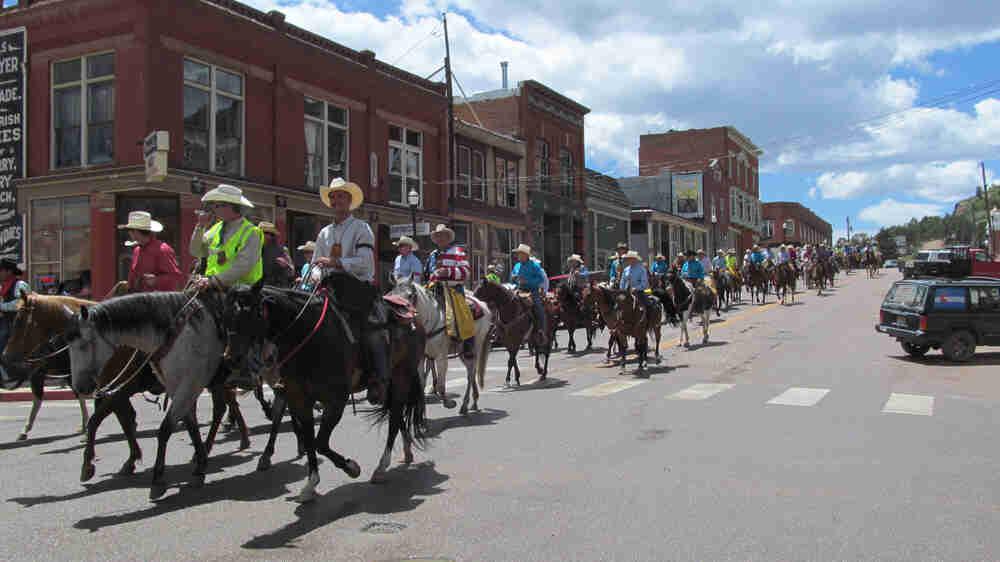Victor
Full Article
Victor, the “City of Mines,” is located in Teller County on the western side of Pikes Peak. Incorporated in 1894, Victor was part of the Cripple Creek District, site of Colorado’s last significant gold mining boom. The city is situated next to Pike National Forest and overlooks the Wet Mountains to the south, while the Mosquito Range is visible to the west. At an altitude of 9,708 feet, Victor enjoys mild summers and can experience harsh winters. Victor had a peak population of around 12,000 at the turn of the century; since 2010 it has had around 400 residents.
History
The Cripple Creek gold rush began in 1890 and spawned numerous towns and cities, most springing up within a twenty-four-square-mile radius. The city of Victor was by far the largest of these, at one point becoming the fourth-largest city in Colorado. Situated at the foot of Battle Mountain, it was named for the huge Victor Mine that dominated the city’s economy and for an early homesteader, Victor C. Adams. Founders Warren, Frank, and Harry Woods platted the town over rolling hills and small canyons, with tents, cabins, and homes being built along the hillsides as the gold rush progressed.
Victor functioned as a workingman’s town populated mostly by gold miners. A number of these men were former silver miners who switched to mining gold after the repeal of the Sherman Silver Purchase Act in 1893. Newcomers to the growing town often found a shortage of housing. Miners found themselves spending most of their meager wages to sleep on a pool table or even on the floor in Victor’s saloons.
Mines literally surrounded the town and employed hundreds of men. Some gold strikes even occurred within the city limits, hence Victor’s nickname, “City of Mines.” Early miners found the working conditions in the mines intolerable, and shortly after the town’s founding, its mine workers were entrenched in the region’s first labor war. Miners went on strike in 1894, demanding an eight-hour workday and pay of at least $3.00 per day. Strikers became violent, blowing up the Strong Mine at the northern edge of town on May 25, 1894. The strike was resolved later that year when the state militia was called out in support of the workers. It was the only time in history when a state guard unit was deployed to assist—rather than break up—a strike.
With the arrival of the Florence & Cripple Creek Railroad in 1894 and the Midland Terminal Railway in 1895, Victor became a prime ore shipping center. The Woods brothers built two trolley systems that traversed the district to Cripple Creek. By 1896 Victor had grown to a population of 8,000 and was made up of hundreds of homes, cabins, and shacks, with a small collection of hotels and rooming houses providing additional lodging for workers. A booming business district sprung up and supplied the town with luxury goods, in addition to necessities such as groceries and hardware. A rollicking red light district flourished along South Third Street, where numerous saloons, bawdy houses, and gambling establishments provided miners with a place to socialize and blow off steam.
Rising from the Ashes
In August of 1899, a local prostitute was washing a gown in kerosene in the red light district. The woman carelessly dropped a cigarette in the wash pan, starting a conflagration that quickly burned out of control. The fire raced northward up a hill toward the business district, igniting every wooden building in its path. The fire burned itself out later that evening. In just a few hours, twelve blocks of the business district and approximately 200 other buildings were burned.
But Victor rebuilt quickly. The post office and several businesses reopened the next day. Within five days, a number of brick buildings were already under construction. Within a month, the Pike’s Peak Power Company was again supplying electricity to the town. By April 1900, the Denver Republican reported, “Victor has risen to her glory from the piled char heaps of late August like a blossoming rose bush.”
The Woods brothers hired architect Matthew Lockwood McBird to design new brick buildings throughout the downtown area. New construction included a rebuilt Gold Coin Club; its new interior included a ballroom, bowling alleys, a dining room, game room, gymnasium, and a library containing 700 books. Employees of the Gold Coin Mine, discovered in 1893 and located across the street from the Gold Coin Club, enjoyed first-class membership and accommodations in the renovated club.
By the end of 1900, the population of Victor had swelled to 12,000. Newcomers to town included travel writer and radio personality Lowell Thomas, who was eight years old when his family moved to Victor. At the age of eighteen, Thomas became editor of the Victor Daily Record newspaper. An even more famous visitor was vice presidential nominee Theodore Roosevelt, who was actually mobbed by angry miners for trying to sell the idea of silver coinage over gold. Upon being elected, Roosevelt visited Victor again and personally shook the hand of each resident.
In 1901 a third railroad, the Colorado Springs & Cripple Creek District Railway—commonly known as the “Short Line”—laid tracks to Victor. It was Theodore Roosevelt who, upon riding the scenic line, uttered his famous phrase, “This is the ride that bankrupts the English language!” By then there were several good producing mines on the outskirts of Victor, including the Portland, the Cresson, the Independence, the Strong, and several others. One-time Victor mayor James Doyle owned the Portland.
Labor War of 1903–4
Miners went on strike a second time in 1903 after mine owners refused to honor the eight-hour workday established in 1894. This time, the Western Federation of Miners (WFM) became involved and managed to shut down a number of mines. At the urging of WFM secretary William “Big Bill” Haywood,” between 3,500 and 4,000 miners walked off the job. To keep the ore coming out of the ground, mine owners hired scabs, nonunionized laborers. Skirmishes between strikers and strikebreakers resulted in the deaths of fifteen miners at the Independence Mine after a cable was “fixed” to fail, causing the elevator to fall and crushing those stuck inside. In another incident, strikers detonated explosives inside the Vindicator Mine, killing more nonunionized workers. Ultimately, Governor James H. Peabody declared martial law and sent the state militia to break up the strike. Striking miners were arrested and detained in bull pens or ordered to leave the district. In September 1903, the entire staff of the Victor Daily Record was arrested after printing an anti–mine owners editorial.
By the spring of 1904, the state troops had been withdrawn, leading to more violence between striking miners and their nonunionized counterparts. On June 6, 1904, an explosion destroyed the train depot at the nearby town of Independence, killing thirteen nonunion miners and badly injuring many others. Historians still debate about who was responsible for the bombing, but whoever was behind it, the ghastly deed ruined the reputation of the WFM and only furthered unrest within the district. At the Miners Union Hall on Victor’s Fourth Street, Sheriff Ed Bell ordered all WFM members outside. When they refused, armed men opened fire on the building. Strikes and violence continued to plague Victor’s nearby mines until the strike was settled in 1907.
Waning Years
Though the strikes hurt the town’s economy and reputation, it was the increasing cost of withdrawing ore from the earth that marked the end for Victor. By 1920, its population had fallen to around 5,600 people. The Victor Opera House burned down that same year and was never rebuilt. In 1949 the Midland Terminal Railway, the last railroad in the district, ceased operations. The last company-owned mine in the Cripple Creek District closed in 1961.
But even as the surrounding towns were slowly abandoned, Victor maintained a steady, if small, population throughout the twentieth century. Area ranches, local businesses, and a few privately owned mines continued feeding the city’s economy. As tourism took hold in the district in the late 1950s, Victor became a popular destination for those wanting to see an authentic Wild West town. Catering to these tourists, the Victor Lowell Thomas Museum opened in 1964, and its downtown area began seeing more new shops, restaurants, and other businesses. Victor was designated a national historic district in 1985.
Today
 Twenty-first-century Victor is made up of full- and part-time residents who take much pride in their town. The legalization of limited stakes gaming in the town of Cripple Creek has helped keep the population afloat, and the Cripple Creek & Victor Mine still operates above town. Annual events include Gold Rush Days each July and Victor Celebrates the Arts each September, as well as cemetery tours, pack burro races, gem shows, mine tours, and more during the summer months.
Twenty-first-century Victor is made up of full- and part-time residents who take much pride in their town. The legalization of limited stakes gaming in the town of Cripple Creek has helped keep the population afloat, and the Cripple Creek & Victor Mine still operates above town. Annual events include Gold Rush Days each July and Victor Celebrates the Arts each September, as well as cemetery tours, pack burro races, gem shows, mine tours, and more during the summer months.
Victor’s transformation from a rough-and-tumble town to tourist outpost mirrors the story of booms and busts familiar to many former mining towns. The shift from mineral extraction to tourism as the main driver of Victor’s economy is a part of bigger changes that have seen Colorado become a major tourism destination in the American West. What once were bawdy houses and taverns have become restaurants and trinket shops. But the changes sweeping through Victor and towns like it demonstrate the adaptable character of residents and the ebb and flow of fortune in the mineral-rich American West.





